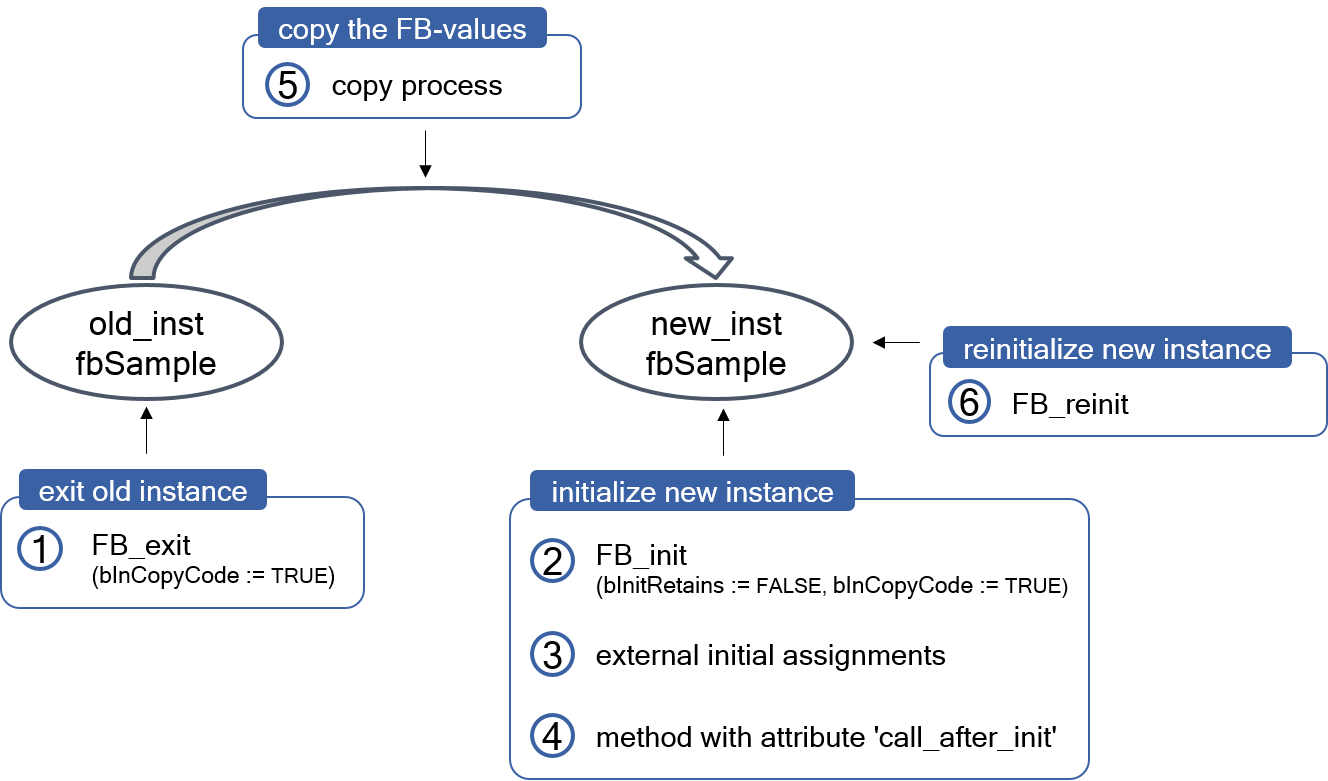Linked list in TwinCAT - Part 1
Object oriented programming brings many new patterns to PLC programming. Today I want to talk about one of them: Linked lists.
Because the length is too long to cover everything in one post, it’s split into 3 parts:
- Part 1 - Intro and node implementation
- Part 2 - Master node implementation
- Part 3 - Example use case
Intro
Many times during programming you come to a problem where you want to go over all instances of a specific function block and change a property or call a method. Let’s say we have a parking full of cars, and we want to lock them all. Without OOP technics you are stuck with some piece of code in all instances that is triggered by a shared variable (global or static). Every car polls the trigger, and locks when the trigger becomes high. As complexity increases, the code will become more and more a real spaghetti monster.
A cleaner way is to create an array with a pointer/reference/interface to all function blocks, and have the program iterate over each element.
Here is a simple example for a car instance list:
VAR_GLOBAL
aCarList: ARRAY [0..2] OF ITF_Car := [
MAIN.fbRedCar,
MAIN.fbGreenCar,
PRG1.fbMyCar
];
END_VAR
The programmer is responsible for maintaining the list. If he adds a car somewhere in the program he needs to add it to the list, otherwise it wont be locked together with the other cars.
You can see that these mistakes will easily happen; the more cars are used and the bigger the parking becomes. A more advanced programmer would let the cars use FB_init to register themselves to the list. You can find an example of this in the famous TcUnit framework. Where the function block pointer of a testsuit is automatically added to a global list:
METHOD FB_init : BOOL
VAR_INPUT
bInitRetains : BOOL;
bInCopyCode : BOOL;
END_VAR
GVL_TcUnit.NumberOfInitializedTestSuites := GVL_TcUnit.NumberOfInitializedTestSuites + 1;
GVL_TcUnit.TestSuiteAddresses[GVL_TcUnit.NumberOfInitializedTestSuites] := THIS;
As memory allocation is static in the Plc, array size is also fixed. (I’m ignoring the __NEW operator here.) That’s why this implementation needs to define a maximum size to reserve an array which can hold enough elements for the application. If you go over that size, you will have problems.
A last point to take into account is that online changes can add, move and remove instances. The code should be able to handle this. References and pointers can become invalid after an online change, while interfaces are automatically adapted by TwinCAT.
Linked list
With a linked list, as the name implies, you link all instances with each other. A car will know the location of the next car, and that car again knows where to find the next car, and so on.
flowchart LR
Car1 ---> Car2
Car2 ---> Car3
Car3 -.-> CarX
In a double linked list, a node not only knows the next node, but also the previous node.
flowchart LR
Car1 ---> Car2
Car2 ---> Car1
Car2 ---> Car3
Car3 ---> Car2
A sentinel node, is a dummy node that is added to the beginning or end to make sure there is always a node available even if the list is empty. I prefer to call this the master node.
flowchart LR
master((Car fleet))
master ---> Car1
Car1 ---> master
Car1 ---> Car2
Car2 ---> Car1
Car2 ---> Car3
Car3 ---> Car2
It is also possible to make the list a circle. And because the handling of adding and removing nodes is easier this way, we are going to build a “Double circular linked list with a sentinel node”.
flowchart LR
master((Car fleet))
master ---> Car1
Car1 ---> master
Car1 ---> Car2
Car2 ---> Car1
Car2 ---> Car3
Car3 ---> Car2
Car3 ---> master
master ---> Car3
- Design
To make it clearer what we are going to build, a list of design choices are listed here:
Node
- Double linked: When a node gets removed, it glues both sides together to restore the link.
- Keeps also a direct link to the master node. It makes many operations easier and faster.
Master node
- Always available even if the list is empty.
- Keeps track of the list size. Because of this, we only allow the master to remove or add nodes.
- Keeps a link to the last accessed node. This can make iterating over the list easier and faster.
- By linking the last node to the master node (=circular), it becomes trivial to add a new node to the end of the list.
Linking
- The linking will be done with interfaces as they survive online changes with memory reallocation.
Node implementation
We start by defining the basic node interface that both the normal and master node will implement. It has two properties that get/set the interface to the previous and next node. p_IsLinkMaster will serve as a constant to differentiate between normal nodes and the master node. This serves as a failsafe to prevent infinite loops, as we create a circular list. The interface itself extends __SYSTEM.IQueryInterface. Later on in part 3, it will be explained why.
INTERFACE ITF_LinkedList_Node EXTENDS __SYSTEM.IQueryInterface
PROPERTY p_IsLinkMaster : BOOL //Only getter
PROPERTY p_ListNext : ITF_LinkedList_Node
PROPERTY p_ListPrevious : ITF_LinkedList_Node
Lets make a function block FB_LinkedList_Node that implements the previous created node interface and add some variables to store links to the neighbor nodes and master. You will find some pragmas around to hide certain variables. This is optional to make online views cleaner, and can be omitted if wanted. Pay close attention to {attribute 'no_copy'} pragmas as they will mostly serve a purpose during online changes.
{attribute 'hide_all_locals'}
FUNCTION_BLOCK FB_LinkedList_Node IMPLEMENTS ITF_LinkedList_Node
VAR
itf_ListNext: ITF_LinkedList_Node;
itf_ListPrevious: ITF_LinkedList_Node;
itf_LinkMaster: ITF_LinkedList_Master;
{attribute 'no_copy'}
_bInCopyCode : BOOL;
END_VAR
The interface implementation is quite straight forward. The properties for the next and previous node are just directly mapped to their internal interface variables. And the p_IsLinkMaster only has a getter with a constant FALSE.
PROPERTY p_ListNext : ITF_LinkedList_Node
//----Get----
p_ListNext := itf_ListNext;
//----Set----
itf_ListNext := p_ListNext;
PROPERTY p_ListPrevious : ITF_LinkedList_Node
//----Get----
p_ListPrevious := itf_ListPrevious;
//----Set----
itf_ListPrevious := p_ListPrevious;
PROPERTY p_IsLinkMaster : BOOL
//----Get----
p_IsLinkMaster := FALSE;
Now it will get a bit more tricky. The master node has the responsibility to add and remove nodes to the list, so that it can keep track of the list size. An application could also have multiple lists. This means we need a way to link a node to the master. We could use FB_init for this, but there are some reasons that a property is chosen here.
- All parameters in FB_init are always required. Building in a default value (ex. default master node link), won’t be possible.
- An extended function block needs to have all FB_init parameters from its child. Making encapsulation harder.
- We still want to have the ability to change the master programmatically during execution. When FB_init is called explicit, all local variables are reinitialized, breaking the existing list.
In the final implementation initializing a node will look like this:
VAR
//Create a node and link it to fbMaster
fbNode: FB_LinkedList_Node := (p_LinkMaster := fbMaster);
END_VAR
On the node function block we are creating, we add the FB_init and FB_reint method to store a copy of the bInCopyCode flag. This is a workaround for the initialization with properties who don’t have access to this flag.
METHOD FB_init : BOOL
VAR_INPUT
bInitRetains : BOOL;
bInCopyCode : BOOL;
END_VAR
_bInCopyCode := bInCopyCode;
METHOD FB_reinit : BOOL
VAR_INPUT
END_VAR
_bInCopyCode := FALSE;
Lets add a property to set/get the master interface. The setter will have extra functionality for online changes and updating a master node. It also uses two methods of the master that we still need to implement: mListRemove(), mListAdd. The getter simply returns the stored master.
PROPERTY p_LinkMaster : ITF_LinkedList_Master
//----Get----
p_LinkMaster := itf_LinkMaster;
//----Set----
IF NOT _bInCopyCode THEN //Set not called during process of copying function block
IF itf_LinkMaster <> 0 THEN
//Remove from old master
itf_LinkMaster.mListRemove( THIS^ );
END_IF
IF p_LinkMaster <> 0 THEN
//Add to new master
p_LinkMaster.mListAdd( THIS^ );
//Store master
itf_LinkMaster := p_LinkMaster;
END_IF
END_IF
To finish it off, we want to remove a node when it’s getting destroyed after the online change. This is done with the FB_exit method.
METHOD FB_exit : BOOL
VAR_INPUT
bInCopyCode : BOOL; // if TRUE, the exit method is called for exiting an instance that is copied afterwards (online change).
END_VAR
IF NOT bInCopyCode THEN
//Destroy and remove from list
IF itf_LinkMaster <> 0 THEN
itf_LinkMaster.mListRemove( THIS^ );
END_IF
END_IF
- Online change
To understand how everything is handled during online changes, it’s good to have a look on the diagram found on InfoSys:
Warm/Cold start + Online change node added
- (2)
FB_initis called withbInCopyCode := False. The value is stored for later use. - (3) The external initial assignments are done, and the setter of
p_LinkMasteris called with our defined master interface. - Because the internal value of
itf_LinkMasteris still 0 and_bInCopyCode=False, the only thing that happens in the setter function is that the node asks the master (if it’s a valid interface) to add himself to the list. - No further steps are taken, and the node is part of the list.
Online change node removed
- (1)
FB_exitis called withbInCopyCode := FALSE. The node checks if it’s connected to a master, and if so asks the master to remove himself from the list.
Online change node moved in memory
- (1) On the old instance the
FB_exitis called withbInCopyCode := True. The call does nothing, and the old instance is still in the list. - (2) A new instance is created and
FB_initis called withbInCopyCode := True. The value ofbInCopyCodeis stored in_bInCopyCode. - (3) The external initial assignments are done, and the setter of
p_LinkMasteris called with our defined master interface. - Because the local
_bInCopyCodeis true, nothing is set or done. - (5) All old values are copied to the new instance. Interfaces are automatically corrected by TwinCAT, making the new instance still linked to its previous, next and master node.
- (6) During
FB_reintthe local_bInCopyCodeis reset. During code execution setting ofp_LinkMasteris possible again.
Slot word
And now we have a fully functional node function block that can be updated/moved/created/destroyed without breaking the link. A last thing to note is that the {attribute 'no_copy'} pragma on _bInCopyCode is more of a safety measurement in case the variable gets set.
In the next part we will implement the master node functionality.

